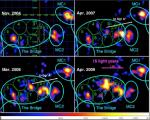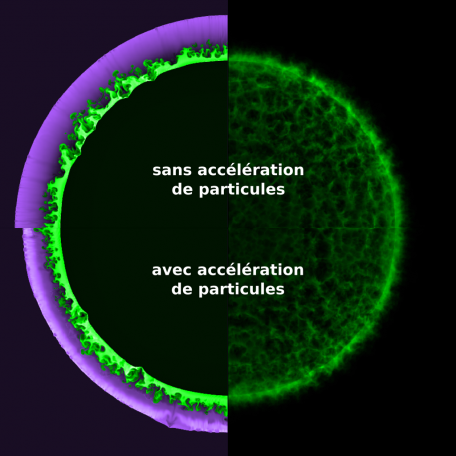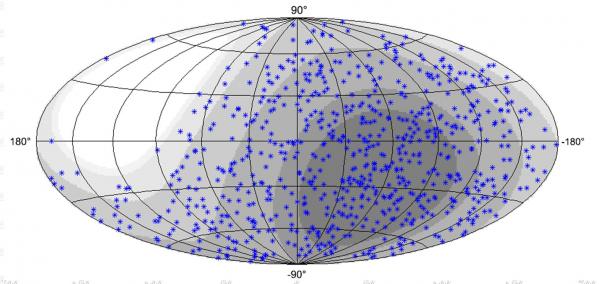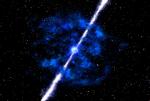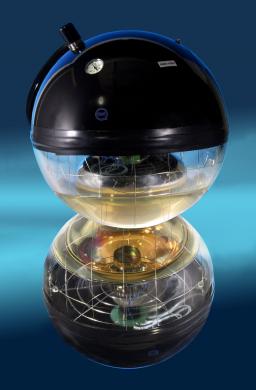The central black hole of the Galaxy, today surprisingly quiet, has undergone, several hundred years ago, a violent phase of activity. This is the conclusion reached by an international team led by astrophysicists of the APC laboratory and including scientists of the Service d'Astrophysique of CEA-Irfu, by studying the high energy emission of molecular clouds located in the central regions of the Galaxy. The scientists have indeed discovered complex variations of this emission, with some of them showing propagation velocity greater than the speed of light. They reveal that a giant outburst, most probably generated by the black hole, took place about 400 years ago. The powerful flare is visible today after reflection by the molecular clouds that play the role of celestial mirrors. The recent history of the region retraced in this way shows that the black hole of the galactic centre is not so different from the supermassive black holes of the active galactic nuclei. This work, based on two long term observing programs of the XMM-Newton and Integral satellites, is the object of two complementary publications in The Astrophysical Journal.
For the first time, the events following the explosion of a star have now been simulated in three dimensions by a team from the Astrophysics Division of CEA-IRFU. The simulation includes the significant contribution of particles accelerated by the shock that is produced in the expansion. Until now, these complex simulations have concentrated either on calculating movement of the expanding ejected material, or on calculating particle acceleration. The evolution of the structure resulting from the explosion of the star, which has survived for over 500 years, shows that the accelerated particles appreciably diminish the size of the shock zone. The results can be compared to X-ray observations carried out in 2005 at the position of the stellar explosion observed in 1572 by the Danish astronomer Tycho Brahe. These simulations come from the COAST computer program and they improve our understanding of the complex acceleration mechanisms of "cosmic rays", particles which flood across the Galaxy at velocities approaching the speed of light.
 See the animation of the expansion following explosion of a star
See the animation of the expansion following explosion of a star
 - see the animation of the expansion (Web version)
- see the animation of the expansion (Web version)
 - see the animation of the expansion (mov)
- see the animation of the expansion (mov)
 - see the animation of the expansion (high def version/ mov)
- see the animation of the expansion (high def version/ mov)
For more détails on the method and results, see : Les restes de supernovae accélérateurs de particules (in french)
It has now been more than two years that Antares1, the underwater telescope installed in the depths of the abyssal plains 2500 m under the Mediterranean, is scanning the skies through the Earth in search of neutrinos. Over a thousand of them have already been observed until today, making it possible to establish the first views of the heavens to search for high-energy cosmic neutrinos, particles that may be able to teach us more about the most violent phenomena in the Universe.
Neutrinos are particles that interact very little with matter. Emitted by the most violent cataclysms of the Universe, they could prove that these phenomena are responsible for cosmic rays, mainly protons, which are constantly bombarding the Earth. These protons actually reach us after having been diverted from their paths by intergalactic magnetic fields, which prevents us from identifying their origin.
Their very weak interaction with matter makes neutrinos hard to detect. This problem can only be overcome by using enormous detectors, shielded against the cosmic rays. Antares, installed off the coast of Toulon, is protected against this radiation by a natural shield - 2000 m of water. Work on the detector took two years and its deployment was achieved in May 2008. Today 885 "eyes", together with the electronic equipment designed and built by CEA-IRFU (Institute of Research into the Fundamental Laws of the Universe) to read and process the data, are strung out in groups of threes along 12 flexible lines 450 m high. These lines are higher than the Eiffel Tower and are anchored to the seabed covering an area as large as four football fields.
The Fermi gamma-ray space telescope [1] has detected the most violent gamma-ray burst ever recorded; a gigantic explosion marking the death of a massive star. Light from this explosion, captured by the Fermi observatory on September 16th 2008, had taken 12.2 billion years to reach Earth. Hence, it must have been produced at a time when the Universe was just 1.5 billion years old. The total amount of energy released makes this the most violent explosion observed in the Universe since the Big Bang. Observed by the Fermi on scales covering more than six decades in energy, this gamma-ray burst demonstrated exceptional properties. Clouds of charged particles were catapulted out during the explosion, at a speed equal to 99.9% of the speed of light! This work, the result of the international Fermi collaboration, with partners from CEA-Irfu, was published on February 19th 2009 in the journal Science express.
The last two lines of the ANTARES detector were connected and powered at a depth of 2500 m on the Mediterranean seabed during the night of May 30, 2008. This brings the number of lines to twelve and completes the construction phase of the largest underwater neutrino telescope ever built.
The lines were immersed a few weeks earlier, close to the other lines that have been tracking cosmic neutrinos since 2006. These particles may be able to tell us more about the most violent phenomena in the Universe.
The event rewards the efforts of the European ANTARES collaboration1 and, more especially, of CEA-IRFU, which has been a major contributor to the project.
